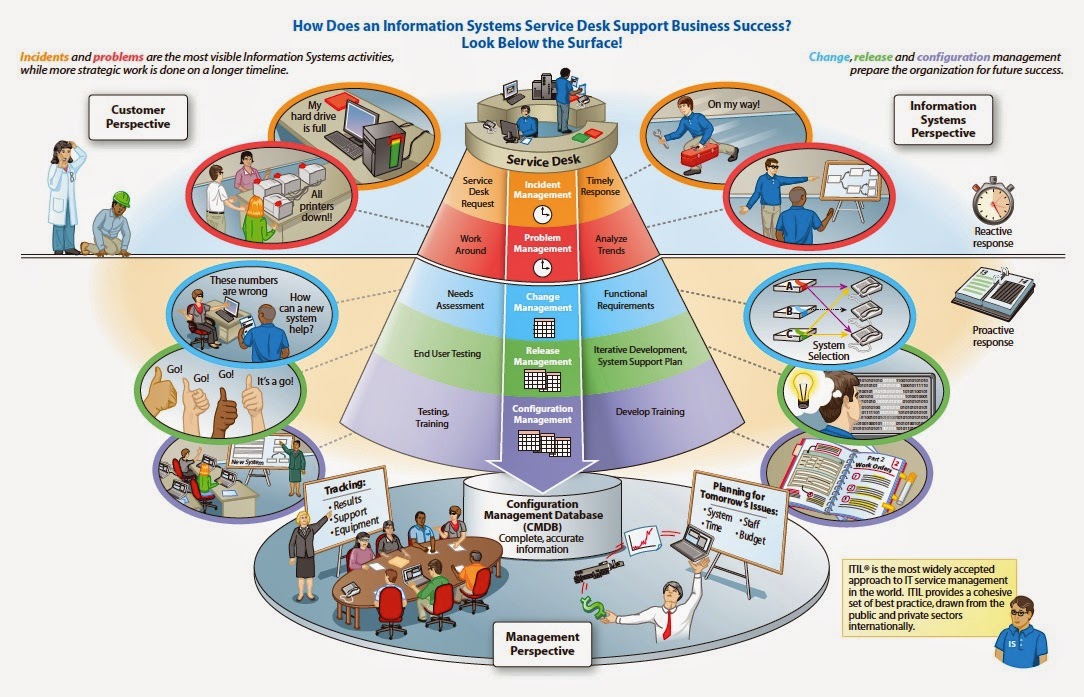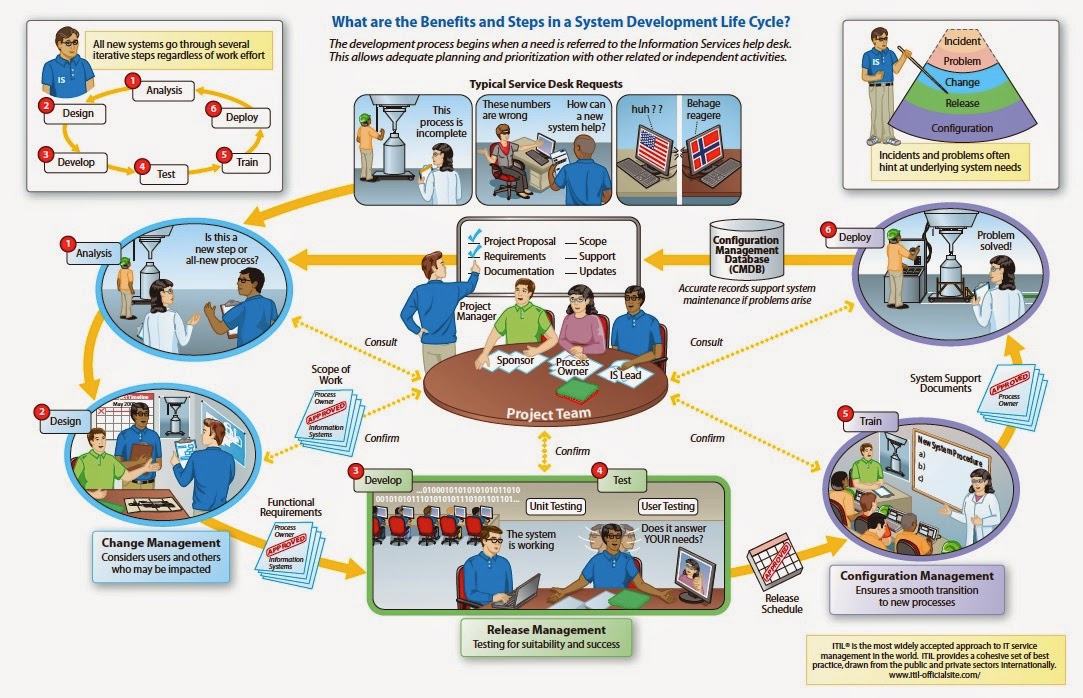IT Infrastructure Library (V3 / 2011) - Stages -> Processes -> Sub-Processes:
Fig-1: ITIL Life Cycle
(I)
Service Stages [5]
|
(II)
Processes [37]
|
(III)
Sub-Processes [116]
|
Service Strategy
[SS]
|
Strategy Management for IT Services
|
Strategic
Service Assessment
|
Service
Strategy Definition
|
||
Service
Strategy Execution
|
||
Service Portfolio Management
|
Define
and Analyze new or changed Services
|
|
Approve
new or changed Services
|
||
Service
Portfolio Review
|
||
Financial Management for IT Services
|
Financial
Management Support
|
|
Financial
Planning
|
||
Financial
Analysis and Reporting
|
||
Service
Invoicing
|
||
Demand Management
|
--None--
|
|
Business Relationship Management
|
Maintain
Customer Relationships
|
|
Identify
Service Requirements
|
||
Sign up
Customers to Standard Services
|
||
Customer
Satisfaction Survey
|
||
Handle
Customer Complaints
|
||
Monitor
Customer Complaints
|
||
Service Design
[SD]
|
Design Coordination
|
Design
Coordination Support
|
Service
Design Planning
|
||
Service
Design Coordination and Monitoring
|
||
Technical
and Organizational Service Design
|
||
Service
Design Review and RFC Submission
|
||
Service Catalogue Management
|
--None--
|
|
Service Level Management
|
Maintenance
of the SLM Framework
|
|
Identification
of Service Requirements
|
||
Agreements
Sign-Off and Service Activation
|
||
Service
Level Monitoring and Reporting
|
||
Risk Management
|
Risk
Management Support
|
|
Business
Impact and Risk Analysis
|
||
Assessment
of Required Risk Mitigation
|
||
Risk
Monitoring
|
||
Capacity Management
|
Business
Capacity Management
|
|
Service
Capacity Management
|
||
Component
Capacity Management
|
||
Capacity
Management Reporting
|
||
Availability Management
|
Design
Services for Availability
|
|
Availability
Testing
|
||
Availability
Monitoring and Reporting
|
||
IT Service Continuity Management
|
ITSCM
Support
|
|
Design
Services for Continuity
|
||
ITSCM
Training and Testing
|
||
ITSCM
Review
|
||
Information Security Management
|
Design
of Security Controls
|
|
Security
Testing
|
||
Management
of Security Incidents
|
||
Security
Review
|
||
Compliance Management
|
Compliance
Register
|
|
Compliance
Review
|
||
Enterprise
Policies and Regulations
|
||
Architecture Management
|
--None--
|
|
Supplier Management
|
Providing
the Supplier Management Framework
|
|
Evaluation
of new Suppliers and Contracts
|
||
Establishing
new Suppliers and Contracts
|
||
Processing
of Standard Orders
|
||
Supplier
and Contract Review
|
||
Contract
Renewal or Termination
|
||
Service Transition
[ST]
|
Change Management
|
Change
Management Support
|
Assessment
of Change Proposals
|
||
RFC
Logging and Review
|
||
Assessment
and Implementation of Emergency Changes
|
||
Change
Assessment by the Change Manager
|
||
Change
Assessment by the CAB
|
||
Change
Scheduling and Build Authorization
|
||
Change
Deployment Authorization
|
||
Minor
Change Deployment
|
||
Post
Implementation Review and Change Closure
|
||
Change Evaluation
|
Change
Evaluation prior to Planning
|
|
Change
Evaluation prior to Build
|
||
Change
Evaluation prior to Deployment
|
||
Change
Evaluation after Deployment
|
||
Project Management (Transition
Planning and Support)
|
Project
Initiation
|
|
Project
Planning and Coordination
|
||
Project
Control
|
||
Project
Reporting and Communication
|
||
Application Development
|
--None--
|
|
Release and Deployment Management
|
Release
Management Support
|
|
Release
Planning
|
||
Release
Build
|
||
Release
Deployment
|
||
Early
Life Support
|
||
Release
Closure
|
||
Service Validation and Testing
|
Test
Model Definition
|
|
Release
Component Acquisition
|
||
Release
Test
|
||
Service
Acceptance Testing
|
||
Service Asset and Configuration
Management
|
Configuration
Identification
|
|
Configuration
Control
|
||
Configuration
Verification and Audit
|
||
Knowledge Management
|
--None--
|
|
Service Operation
[SO]
|
Event Management
|
Maintenance
of Event Monitoring Mechanisms and Rules
|
Event
Filtering and 1st Level Correlation
|
||
2nd
Level Correlation and Response Selection
|
||
Event
Review and Closure
|
||
Incident Management
|
Incident
Management Support
|
|
Incident
Logging and Categorization
|
||
Immediate
Incident Resolution by 1st Level Support
|
||
Incident
Resolution by 2nd Level Support
|
||
Handling
of Major Incidents
|
||
Incident
Monitoring and Escalation
|
||
Incident
Closure and Evaluation
|
||
Pro-Active
User Information
|
||
Incident
Management Reporting
|
||
Request Fulfilment
|
Request
Fulfilment Support
|
|
Request
Logging and Categorization
|
||
Request
Model Execution
|
||
Request
Monitoring and Escalation
|
||
Request
Closure and Evaluation
|
||
Access Management
|
Maintenance
of Catalogue of User Roles and Access Profiles
|
|
Processing
of User Access Requests
|
||
Problem Management
|
Proactive
Problem Identification
|
|
Problem
Categorization and Prioritization
|
||
Problem
Diagnosis and Resolution
|
||
Problem
and Error Control
|
||
Problem
Closure and Evaluation
|
||
Major
Problem Review
|
||
Problem
Management Reporting
|
||
IT Operations Control
|
--None--
|
|
Facilities Management
|
--None--
|
|
Application Management
|
--None--
|
|
Technical Management
|
--None--
|
|
Continual Service Improvement
[CSI]
|
Service Review
|
--None--
|
Process Evaluation
|
Process
Management Support
|
|
Process
Benchmarking
|
||
Process
Maturity Assessment
|
||
Process
Audit
|
||
Process
Control and Review
|
||
Definition of CSI Initiatives
|
--None--
|
|
Monitoring of CSI Initiatives
|
--None--
|

Fig-2: ITIL Service Support Desk
Fig-3: How to work with a service desk

Fig-4: ITIL Software Development Life cycle



